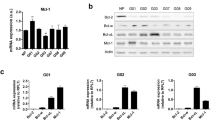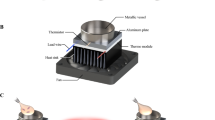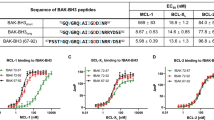Abstract
Cellular stress eliminates irreversibly damaged cells by initiating the intrinsic death pathway. Cell stress is sensed by pro- and antiapoptotic members of the Bcl-2 protein family, which regulate the release of apoptogenic factors, such as cytochrome c, from mitochondria. Exposure of cells to hyperthermia results in the activation of the proapoptotic Bcl-2 family protein Bax, which plays an essential role in cytochrome c release. Heat directly affects Bax activity in vitro; however, antiapoptotic Bcl-2 family proteins, such as Bcl-xL, can suppress this activation, suggesting that a second heat-sensitive step must be breached before apoptosis ensues in cells exposed to hyperthermia. Here we show that heat shock causes the loss of Mcl-1 protein. Depletion of Noxa by short hairpin RNA protected cells from hyperthermia by preventing Mcl-1 degradation. Heat shock caused the dissociation of Noxa from Mcl-1, which allowed binding of the BH3-containing ubiquitin ligase Mule followed by Mcl-1 ubiquitination and degradation. Overexpression of Hsp70, which prevents heat-induced Bax activation, stabilized Mcl-1 protein levels in heat-shocked cells. This resulted from reduced Mule binding and ubiquitination as well as enhanced Mcl-1 expression compared with cells without Hsp70. Our results demonstrate that loss of Mcl-1 is a critical heat-sensitive step leading to Bax activation that is controlled by Hsp70.
Similar content being viewed by others
Log in or create a free account to read this content
Gain free access to this article, as well as selected content from this journal and more on nature.com
or
Abbreviations
- CHAPS:
-
3-[(3-cholamidopropyl)dimethylammonio]-1-propane sulfonate hydrate
- DEVDase:
-
protease activity toward Ac-DEVD-AMC (N-acetyl-Asp-Glu-Val-Asp-(7-amino-4-methylcoumarin)
- EGS:
-
ethylene glycol bis-(succinimidyl succinate)
- IP:
-
immunoprecipitation
- PBS:
-
phosphate-buffered saline
- SDS-PAGE:
-
sodium dodecyl sulfate-polyacrylamide gel electrophoresis
- shRNA:
-
short hairpin RNA
- UV:
-
ultraviolet
References
Taylor RC, Cullen SP, Martin SJ . Apoptosis: controlled demolition at the cellular level. Nat Rev Mol Cell Biol 2008; 9: 231–241.
Antonsson B, Montessuit S, Sanchez B, Martinou JC . Bax is present as a high molecular weight oligomer/complex in the mitochondrial membrane of apoptotic cells. J Biol Chem 2001; 276: 11615–11623.
Leber B, Lin J, Andrews DW . Embedded together: the life and death consequences of interaction of the Bcl-2 family with membranes. Apoptosis 2007; 12: 897–911.
Adams JM, Cory S . The Bcl-2 apoptotic switch in cancer development and therapy. Oncogene 2007; 26: 1324–1337.
Chipuk JE, Green DR . How do BCL-2 proteins induce mitochondrial outer membrane permeabilization? Trends Cell Biol 2008; 18: 157–164.
Stankiewicz AR, Lachapelle G, Foo CP, Radicioni SM, Mosser DD . Hsp70 inhibits heat-induced apoptosis upstream of mitochondria by preventing Bax translocation. J Biol Chem 2005; 280: 38729–38739.
Pagliari LJ, Kuwana T, Bonzon C, Newmeyer DD, Tu S, Beere HM et al. The multidomain proapoptotic molecules Bax and Bak are directly activated by heat. Proc Natl Acad Sci USA 2005; 102: 17975–17980.
Opferman JT . Unraveling MCL-1 degradation. Cell Death Differ 2006; 13: 1260–1262.
Derenne S, Monia B, Dean NM, Taylor JK, Rapp MJ, Harousseau JL et al. Antisense strategy shows that Mcl-1 rather than Bcl-2 or Bcl-x(L) is an essential survival protein of human myeloma cells. Blood 2002; 100: 194–199.
Michels J, Johnson PW, Packham G . Mcl-1. Int J Biochem Cell Biol 2005; 37: 267–271.
Bae J, Leo CP, Hsu SY, Hsueh AJ . MCL-1S, a splicing variant of the antiapoptotic BCL-2 family member MCL-1, encodes a proapoptotic protein possessing only the BH3 domain. J Biol Chem 2000; 275: 25255–25261.
Nechushtan A, Smith CL, Lamensdorf I, Yoon SH, Youle RJ . Bax and Bak coalesce into novel mitochondria-associated clusters during apoptosis. J Cell Biol 2001; 153: 1265–1276.
Zhong Q, Gao W, Du F, Wang X . Mule/ARF-BP1, a BH3-only E3 ubiquitin ligase, catalyzes the polyubiquitination of Mcl-1 and regulates apoptosis. Cell 2005; 121: 1085–1095.
Maurer U, Charvet C, Wagman AS, Dejardin E, Green DR . Glycogen synthase kinase-3 regulates mitochondrial outer membrane permeabilization and apoptosis by destabilization of MCL-1. Mol Cell 2006; 21: 749–760.
Inoshita S, Takeda K, Hatai T, Terada Y, Sano M, Hata J et al. Phosphorylation and inactivation of myeloid cell leukemia 1 by JNK in response to oxidative stress. J Biol Chem 2002; 277: 43730–43734.
Han J, Goldstein LA, Gastman BR, Froelich CJ, Yin XM, Rabinowich H . Degradation of Mcl-1 by granzyme B: implications for Bim-mediated mitochondrial apoptotic events. J Biol Chem 2004; 279: 22020–22029.
Willis SN, Chen L, Dewson G, Wei A, Naik E, Fletcher JI et al. Proapoptotic Bak is sequestered by Mcl-1 and Bcl-xL, but not Bcl-2, until displaced by BH3-only proteins. Genes Dev 2005; 19: 1294–1305.
Czabotar PE, Lee EF, van Delft MF, Day CL, Smith BJ, Huang DC et al. Structural insights into the degradation of Mcl-1 induced by BH3 domains. Proc Natl Acad Sci USA 2007; 104: 6217–6222.
Han J, Goldstein LA, Hou W, Rabinowich H . Functional linkage between NOXA and Bim in mitochondrial apoptotic events. J Biol Chem 2007; 282: 16223–16231.
Warr MR, Acoca S, Liu Z, Germain M, Watson M, Blanchette M et al. BH3-ligand regulates access of MCL-1 to its E3 ligase. FEBS Lett 2005; 579: 5603–5608.
Mosser DD, Martin LH . Induced thermotolerance to apoptosis in a human T lymphocyte cell line. J Cell Physiol 1992; 151: 561–570.
Mosser DD, Caron AW, Bourget L, Denis-Larose C, Massie B . Role of the human heat shock protein hsp70 in protection against stress-induced apoptosis. Mol Cell Biol 1997; 17: 5317–5327.
Mosser DD, Caron AW, Bourget L, Meriin AB, Sherman MY, Morimoto RI et al. The chaperone function of hsp70 is required for protection against stress-induced apoptosis. Mol Cell Biol 2000; 20: 7146–7159.
Naik E, Michalak EM, Villunger A, Adams JM, Strasser A . Ultraviolet radiation triggers apoptosis of fibroblasts and skin keratinocytes mainly via the BH3-only protein Noxa. J Cell Biol 2007; 176: 415–424.
Clohessy JG, Zhuang J, Brady HJ . Characterisation of Mcl-1 cleavage during apoptosis of haematopoietic cells. Br J Haematol 2004; 125: 655–665.
Gabai VL, Meriin AB, Mosser DD, Caron AW, Rits S, Shifrin VI et al. Hsp70 prevents activation of stress kinases. A novel pathway of cellular thermotolerance. J Biol Chem 1997; 272: 18033–18037.
Meller R, Cameron JA, Torrey DJ, Clayton CE, Ordonez AN, Henshall DC et al. Rapid degradation of Bim by the ubiquitin–proteasome pathway mediates short-term ischemic tolerance in cultured neurons. J Biol Chem 2006; 281: 7429–7436.
Domina AM, Vrana JA, Gregory MA, Hann SR, Craig RW . MCL1 is phosphorylated in the PEST region and stabilized upon ERK activation in viable cells, and at additional sites with cytotoxic okadaic acid or taxol. Oncogene 2004; 23: 5301–5315.
Esser C, Alberti S, Hohfeld J . Cooperation of molecular chaperones with the ubiquitin/proteasome system. Biochim Biophys Acta 2004; 1695: 171–188.
Liu RY, Li X, Li L, Li GC . Expression of human hsp70 in rat fibroblasts enhances cell survival and facilitates recovery from translational and transcriptional inhibition following heat shock. Cancer Res 1992; 52: 3667–3673.
Mosser DD, Morimoto RI . Molecular chaperones and the stress of oncogenesis. Oncogene 2004; 23: 2907–2918.
Morimoto RI . Proteotoxic stress and inducible chaperone networks in neurodegenerative disease and aging. Genes Dev 2008; 22: 1427–1438.
Cuconati A, Mukherjee C, Perez D, White E . DNA damage response and MCL-1 destruction initiate apoptosis in adenovirus-infected cells. Genes Dev 2003; 17: 2922–2932.
Nijhawan D, Fang M, Traer E, Zhong Q, Gao W, Du F et al. Elimination of Mcl-1 is required for the initiation of apoptosis following ultraviolet irradiation. Genes Dev 2003; 17: 1475–1486.
Gao M, Karin M . Regulating the regulators: control of protein ubiquitination and ubiquitin-like modifications by extracellular stimuli. Mol Cell 2005; 19: 581–593.
Willis SN, Fletcher JI, Kaufmann T, van Delft MF, Chen L, Czabotar PE et al. Apoptosis initiated when BH3 ligands engage multiple Bcl-2 homologs, not Bax or Bak. Science 2007; 315: 856–859.
Chen L, Willis SN, Wei A, Smith BJ, Fletcher JI, Hinds MG et al. Differential targeting of prosurvival Bcl-2 proteins by their BH3-only ligands allows complementary apoptotic function. Mol Cell 2005; 17: 393–403.
Certo M, Del Gaizo Moore V, Nishino M, Wei G, Korsmeyer S, Armstrong SA et al. Mitochondria primed by death signals determine cellular addiction to antiapoptotic BCL-2 family members. Cancer Cell 2006; 9: 351–365.
Podar K, Gouill SL, Zhang J, Opferman JT, Zorn E, Tai YT et al. A pivotal role for Mcl-1 in Bortezomib-induced apoptosis. Oncogene 2008; 27: 721–731.
MacCallum DE, Melville J, Frame S, Watt K, Anderson S, Gianella-Borradori A et al. Seliciclib (CYC202, R-Roscovitine) induces cell death in multiple myeloma cells by inhibition of RNA polymerase II-dependent transcription and down-regulation of Mcl-1. Cancer Res 2005; 65: 5399–5407.
Kang MH, Wan Z, Kang YH, Sposto R, Reynolds CP . Mechanism of synergy of N-(4-hydroxyphenyl)retinamide and ABT-737 in acute lymphoblastic leukemia cell lines: Mcl-1 inactivation. J Natl Cancer Inst 2008; 100: 580–595.
Lachapelle G, Radicioni SM, Stankiewicz AR, Mosser DD . Acute acidification or amiloride treatment suppresses the ability of Hsp70 to inhibit heat-induced apoptosis. Apoptosis 2007; 12: 1479–1488.
Acknowledgements
This study was supported by the Natural Science and Engineering Research Council of Canada.
Author information
Authors and Affiliations
Corresponding author
Additional information
Edited by J Silke
Rights and permissions
About this article
Cite this article
Stankiewicz, A., Livingstone, A., Mohseni, N. et al. Regulation of heat-induced apoptosis by Mcl-1 degradation and its inhibition by Hsp70. Cell Death Differ 16, 638–647 (2009). https://doi.org/10.1038/cdd.2008.189
Received:
Revised:
Accepted:
Published:
Issue date:
DOI: https://doi.org/10.1038/cdd.2008.189
Keywords
This article is cited by
-
Pro-death signaling of cytoprotective heat shock factor 1: upregulation of NOXA leading to apoptosis in heat-sensitive cells
Cell Death & Differentiation (2020)
-
Blockade of HSP70 by VER-155008 synergistically enhances bortezomib-induced cytotoxicity in multiple myeloma
Cell Stress and Chaperones (2020)
-
The elimination of miR-23a in heat-stressed cells promotes NOXA-induced cell death and is prevented by HSP70
Cell Death & Disease (2014)
-
Synergic antitumor effect of SKLB1002 and local hyperthermia in 4T1 and CT26
Clinical and Experimental Medicine (2014)
-
Consequences of heat shock protein 72 (Hsp72) expression and activity on stress-induced apoptosis in CD30+ NPM–ALK+ anaplastic large-cell lymphomas
Leukemia (2012)



